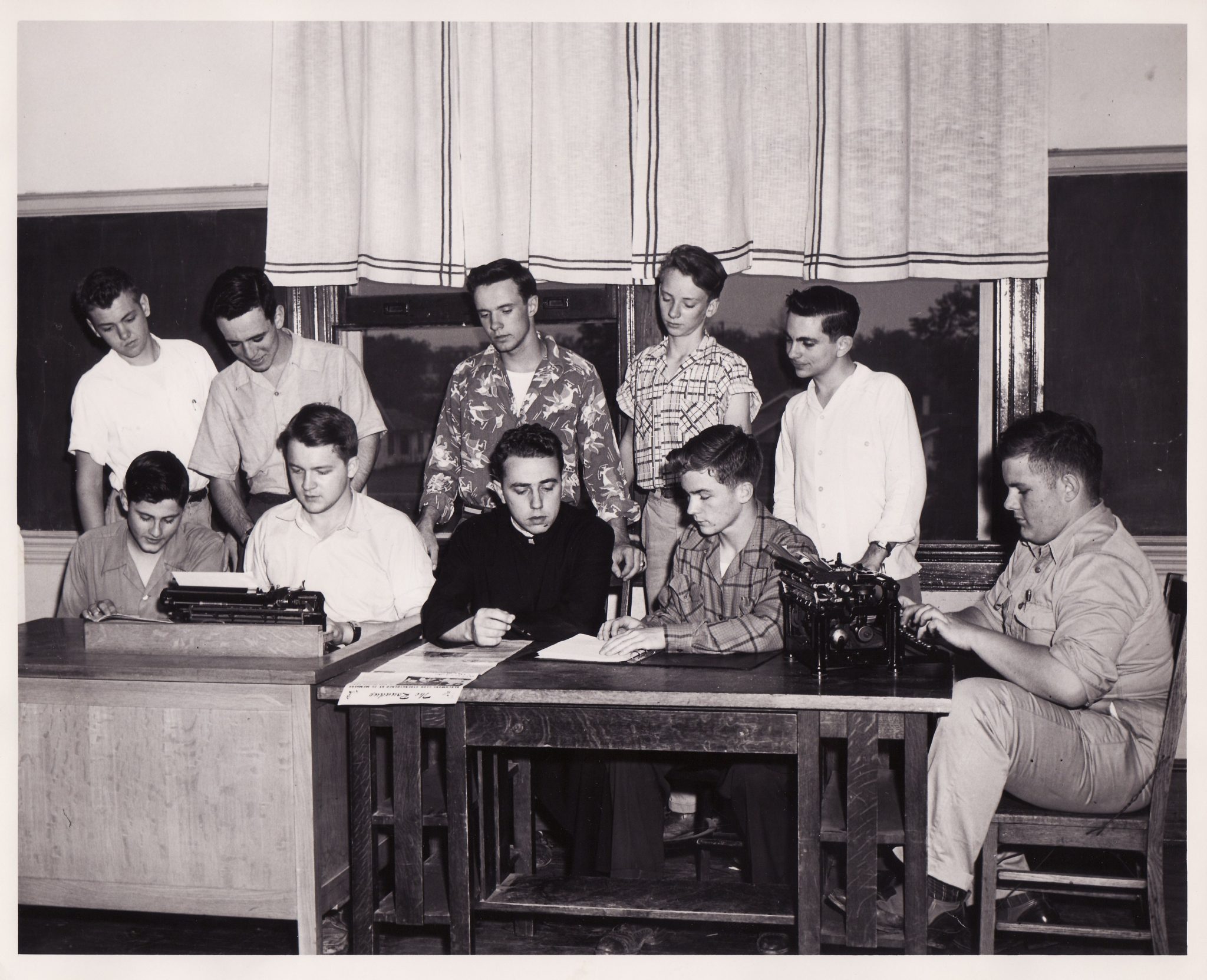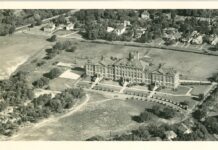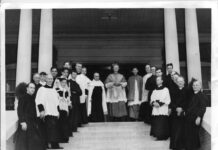In October 1949 the paper reported that it had been accepted into the Catholic School Press Association “with a rating of First Honors, the second highest classification for High School newspapers. The rating was based on all of last year’s monthly publications, and a separate award, Second Honors, was given to The Last Roundup.”
In March 1950 The Roundup sponsored two writing contests. The first was an essay over the topic: The Catholic Answer to Communism. The students could research the topic to ready themselves for the contest but bring no source work with them to the library after school when the event was held. The winners would be recognized at graduation. The second contest was to write an original short story. The winner received $5.00 and had his story published in The Last Roundup. The banquet was held at Italian Village on May 4.

In 1952 – 1953 The Roundup was almost shut down for lack of funds. The Ministers Diary of September 1952 notes the decision that “In view of the Bishop’s attitude concerning interference of the selling of advertising in High School Papers with His Diocesan newspaper advertising, the printing of the Roundup will be discontinued, and a Ditto Edition of several pages will appear at intervals.”
Fortunately, a group of mothers held a series of Bingo parties to raise funds. The short story contest continued. The requirements were: “The story must be original and its length must be five hundred to fifteen hundred words. Stories that are typewritten must be double spaced on regular typewriting paper, and handwritten copies must be done neatly in ink.”
The paper had two moderators this year, Mr. C. E. Johnson, S. J. and Mr. J. L. Vessels, S. J., one to deal with the financial problems and one to oversee the production. They announced an English essay contest over the life of St. Francis Xavier, What Does It Profit? 46 boys entered.
The Province Prefect report in 1954 noted that the paper “is financed by sponsors, since advertising in school papers is not countenanced in Dallas. The article are well written and have the spontaneity and freshness of the student-writers who produce them.”

The 1955 yearbook, under the direction of Mr. Earl Johnson, S. J., became the first hardcover yearbook. The Province Prefect report noted: “This year for the first time the school will produce a yearbook, instead of the ‘Final Roundup.’ It is understood that the yearbook can be produced as cheaply as the booklet that the school formerly published. The difference is in that the yearbook will be done by offset process, whereas in the booklet it was necessary to use cuts and regular printing. The plan is good. But as the school grows larger there be a tendency to let the yearbook become an expensive operation. I think that this should be guarded against.”
In 1956 – 1957 the staff was split into two groups, one for The Roundup and one for The Last Roundup. The March 8, 1957, Roundup reported extensively about the paper’s history and behind the scenes work. Under the direction of Mr. Richard W. McGowan, S. J., the newspaper returned “to newsprint in eight pages. This change enables The Roundup both to give a more current coverage of the news and to publish more pictures.”
According to the news coverage, McGowan would often claim in a stern and forbidding voice: “This is absolutely the last paper I’m going to put out. If those editors want to put out another one, it’s up to them . . . don’t expect me to do all the work again.” However, as time passed between editions McGowan regained his good humor and helped.
At this time The Roundup sent copies to many places across the city, state, country, and world. “In Dallas the Roundup [sic] is sent to most of the public high schools, to all the pastors and parish schools, to the Texas Catholic, the Chancelory, and the Public Library.”

It went to all Texas schools, both Catholic and non-Catholic, with which the school played football. It was mailed to all the Jesuit High Schools, to many Jesuit houses, and to priests who had served at Jesuit Dallas. In addition, it was mailed to Jesuits overseas, from Belgium, Ceylon, Cuba, Rome and Spain. Special “couriers” brought the paper to the local girls schools.
The 1957 Last Roundup, under the direction of Mr. R. Miller S. J. and Tracy Johnson as editor-in-chief, debuted a padded cover which would remain for some time. It sold for $4.00 with a $2.00 deposit. As the March 8, 1957 edition explains, “The sponsor drive this year is limited to Roundup and Las Roundup members. This drive will pay for the Roundup during the year . . . which is currently being distributed free, and will also help pay expenses on the Last Roundup. Each member’s quota is $100.00.”
The 1957 banquet was held at Donlen’s restaurant on Sunday, April 21. The staff was noted not only for the more frequent coverage but also for distributing the paper free since it was supported by profits from the yearbook. One speaker, graduate Mr. Burns and a former staff member noted that reporting and writing would help the students throughout their lives. “He said the ability of a person to express himself and his ideas would always . . . mark him as a learned man” (The Roundup May 1957).
All this work demanded workers, and the editor issued a passionate plea for more staff: “Five hundred students, all taking English four years, and thirty-five put out the school paper.”
Sources: The Principal’s and Minister’s Diaries, The Province Prefect Annual Report 1953, The Mothers’s Club Scrapbooks, and the student school newspaper, The Roundup)




